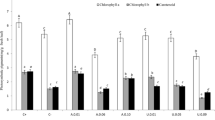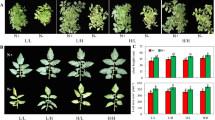Abstract
Tomato seedlings absorbed increasing amounts of nitrate-N. The total uptake was doubled as the concentration of nitrate was quadruplicated. NO3−N absorption seemed to be accompanied by efflux of OH− ions which shift the pH of the media to the alkaline side. A minor fraction of the absorbed nitrate accumulated in the tissues while the major part was assimilated into peptides and proteins. The dry matter gain was by the end of experiment relatively higher than the control samples raised on nitrogen-free nutrient solution.
Nitrate assimilation seemed to involve its reduction down to ammonia level. Since neither nitrite nor ammonia was recovered in the tissue-medium system, it was postulated that the rate of reduction was slower than the rate of product assimilation. The first step in nitrate reduction (nitrate→nitrate) appeared to be limiting while further reduction steps occurred rapidly and accompanied by simultaneous assimilation of ammonia.
The enzyme responsible for the first step of nitrate reduction,i.e., nitrate reductase, was extracted from tomato shoots and roots. The activity in root extract amounted to about 30% of that of the shoot. This may suggest the localization of nitrate reduction in the leaves and realizes the relation between nitrate metabolism and photosynthesis.
Similar content being viewed by others
References
Beevers L and Hageman R H 1969 Nitrate reduction in higher plants. Annu. Rev. Plant Physiol. 20, 495–522.
BreazealeIn Bergman W 1958 Encyclopedia of Plant Physiol. Ed. W. Ruhland. Vol IV 37–89. Springer verlag.
Burris R H 1959 Nitrogen nutrition. Annu. Rev. Plant Physiol. 10, 301–328.
Burström H 1945 The nitrate nutrition of plants. Ann. Agr. Coll. Sweden. 13, 1–86.
Chibnall A C, Rees M W and Williams E F 1943 Total nitrogen content of egg albumin and other proteins. Biochem. J. 37, 354–359. (Chem. Abstr. 38, 128i, 1944).
Crafts-Bradner J S and Harper E J 1982 NR. by roots of soybean. Plant Physiol. 69, 1298–1303.
Delory G E 1949 Photo electric methods in clinical biochemistry. Reviewed Analyst. 74, 574. (Chem. Abstr. 44, 1559i, 1950).
Evans H J and Nason A 1953 Pyridine nucleotide-nitrate reductase from extracts of higher plants. Plant Physiol., 28, 233–254.
Ghosh B P and Burris R H 1950 Utilization of nitrogen compounds by plants. Soil Sci. 70, 187–203.
Hatata M A 1975 Ph. D. Thesis, University of Alexandria. Effect of certain salts on the growth and metabolism of young plant organs.
Hewitt E J, Agrawala S C and Williams A H 1957 Mo as plant nutrient (VIII) effect of different Mo levels and supplies on the N fractions in cauliflower plants grown in sand culture. J. Hort. Sci. 32–34 (Chem. Abstr., 51, 6783f, 1957).
Hodges T K 1973 Ion absorption by plant roots. Adv. Agron. 25, 163–207.
Lee R B 1979 Sources of reductant for nitrate assimilation in non-photosynthetic tissue. Review, Plant Cell Environment., 3, 65–90.
Munn D A and Jackson W A 1978 Nitrate and ammonium uptake by rooted cuttings of sweet potato. Agron. J. 70, 312–316.
Mueting D and Kaiser E 1963 The quantitative determination of α-amino nitrogen in biological material by means of the ninhydrin reaction. Physiol. Chem. 202, 655–675.
Nason A and Evans H J 1953 Triphosphopyridine nucleotide-nitrate reductase in Neurospora. J. Biol. Chem. 202, 655–673.
Notton B A and Hewitt E J 1971 Incorporation of radioactive molybdenum into protein during nitrate reductase formation and effect of molybdenum on nitrate reductase and diaphorase activities of spinach (Spinacea oleracea L.) Plant Cell Physiol. 12, 465–477.
Pate J S 1973 Uptake, assimilation and transport of nitrogen compounds by plants. Soil. Biol. Biochem. 5, 109–119.
Pirie N W 1955In Modern Method of Plant Analysis, IV, 23, Eds. R Paech and M V Trag, Springer-Verlag, Berlin.
Raven J A and Smith F A 1976 Nitrogen assimilation and transport in vascular land plants in relation to intracellular regulation. New Phytol. 76, 415–430.
Sanderson G W and Cocking E C 1964 Enzymic assimilation of nitrate in tomato plants. I. Reduction of nitrate to nitrite. Plant Physiol. 39, 416–422.
Smith F A 1973 The internal control of nitrate uptake into excised barley root with differing salt contents. New Phytol. 72, 769–782.
Snell F D and Snell C T 1949 Colorimetric methods of analysis. Vol. 2 (3rd ed.), pp 785–807. D. Van Nostrand Company, Inc. (New York).
Thomas R W, David R C Jr and Jackson W A 1982 Nitrate Uptake, root and shoot growth, and ion balance of soybean plants during acclimation to root zone acidity. Bot. Gaz. 43, 5–14.
Younis A E 1962 Nitrate and nitrite assimilation by radish root slices. Acta Biol. Hung. 13, 197–206.
Author information
Authors and Affiliations
Rights and permissions
About this article
Cite this article
Maghrabi, Y.M.S., Younis, A.E. & Abozinah, F.S. Nitrogen metabolism in tomato seedlings. Plant Soil 85, 395–402 (1985). https://doi.org/10.1007/BF02220194
Received:
Revised:
Issue Date:
DOI: https://doi.org/10.1007/BF02220194




